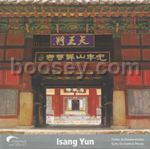2(II=picc).2.2(II=bcl).2(II=dbn)-4.3.2.0-timp.perc(4):tam-t/2cym/SD/TD/BD/tgl-harp-strings
Abbreviations (PDF)
B&B
Bara, the first orchestral piece composed by Yun in Europe, was followed in 1960 by the Symphonic Scene. He then wrote the Colloides sonores (1961) for string orchestra. Loyang for chamber ensemble followed in 1962. Accordingly, Fluctuations was Yun’s fourth orchestral piece; the score was begun in 1963 and concluded in Berlin on March 17, 1964. Like "colloid," "fluctuation" is a term from chemistry, and both terms are related to liquids. A colloid is a "substance occurring in the finest, microscopically no longer detectable dispersion in a liquid or a gas" (Duden, Fremdwörterbuch, 1997). Yun himself explained in his conversation with Luise Rinser in 1977 (pp. 76-77), "From different directions, so to speak, the smallest sound elements come together and develop organically, until they have become a complete whole. Then comes the moment when this whole again breaks up into its elements; they fly in all directions and form new constellations where they encounter other little elements. These connections can repeatedly be broken up."
In contrast to "colloid," "fluctuation" designates the sloshing or swashing back and forth of encapsulated liquids. And in contrast to the crystallization and disintegration processes linked by Yun to the colloid, in Fluctuations he aims in increased measure at longer musical developments, plausible formal structure, and connection on the large scale. In both works abstract compositional ideas occupy the foreground. The fact that programmatic contents are no longer transmitted here does not mean, however, that they did not play any role in the compositional process: "There is always something or other, but I do not always have to say it" (Yun, 1990).
The sloshing or swashing is translated by Yun into the succession of alternating sound groups. The comparatively clear architectonic formal structure and the manner in which he calls up and coordinates his vocabulary in the individual sound groups almost in the manner of an étude presumably occasioned him to make the statement that Fluctuations was "technically" designed and realized. Two framing sections – bars 1-67 (with the continuous pulse of quarter = 56) and bars 186-219 (with the uniform tempo quarter = 60) – enclose a middle section (bars 68-185) geared toward contrasting alternations and effective intensifications. Yun changes the indications of tempo eleven times in the middle section; first he establishes the contrasting pairs (quarter 88 – 72, 88 – 72, 60 – 80, 60 – 80) and then a continuous acceleration (88 – accelerando – 122) forming the greatest contrast toward the concluding part.
Expansive, long-drawn-out sounds dominate in the framing parts. In the first phase of the quiet and dark beginning a short flute sound appears as the first light and high point. In the second phase Yun combines the strings with brass instruments and low woodwinds to form a first larger sound plane. The trumpets, sforzato, set a short and forceful accent here; the articulation of a first tutti plane begins from a2 of the oboe. The strings, harp, and brass instruments then form a bridge, a yônum, to the high winds. The renewed sound structure through the strings (with the harp and percussion) finally follows thoroughly from the depths (in part noisy string tremolos).
The alternating of the groups becomes clearer in the middle part: woodwinds in restless motion, brief string inserts; a short tutti aims at a forceful brass chord (bar 77). The strings again initiate a long development as well as gradual evolutionary processes again aiming at a brass chord (bar 99). Varied repetition; a long tutti wind sound appears on the symmetrical axis of the composition (bars 124-130). Yun’s instrumentation as rhetoric (Erwin Koch-Raphael): woodwinds, woodwinds with strings, woodwinds alone, then with brass instruments, finally a tutti (bars 156-161) temporarily thinned out to sound groups in sequence. A brass chord, among other things, is inserted in the manner of a signal into the turbulent simultaneity of the strings and woodwinds.
Lastly, the solo brass chord introducing the concluding part functions as an envelope of flickeringly animated turbulence for the decisive word of might. The rival sound groups are heard simultaneously for a short time, until Yun leaves the open end up to a high string plane.
Walter-Wolfgang Sparrer (2004, translated by Susan Marie Praeder)

Radio-Symphonie-Orchester Berlin / Peter Ronnefeld
Internationale Isang Yun Gesellschaft IYG 003
